Experimental and Modelling Research on the Effect of Prior Ferrite on Bainitic Transformation in Medium-Carbon Bainitic Steel
Abstract
1. Introduction
2. Experimental Procedure
3. Results
3.1. Experimental Results
3.1.1. Dilatometric Analysis
3.1.2. Microstructure Characterizations
3.2. Modelling and Results
3.2.1. Bainite Transformation Model
3.2.2. Modeling Results
4. Conclusions
- (1)
- The lower the intercritical annealing temperature, the higher the volume fraction of prior ferrite formed before isothermal bainite transformation. The incubation time decreased from 687 s to 20 s and the completion time also decreased from 6018 s to 4680 s, while the bainite maximum transformation rate increased from 0.0271 μm/s to 0.0436 μm/s with an increase in the volume fraction of prior ferrite.
- (2)
- The introduction of prior ferrite can increase the number of nucleation sites, improve the bainite transformation rate at the beginning of the isothermal period, and accelerate the whole bainite transformation. The bainite sheaves nucleate not only at prior austenite grain boundaries, but also at the ferrite/austenite interface. The acceleration mechanism of prior ferrite on the bainite transformation is reflected in a shortened incubation time rather than the growth of bainite sheaves.
- (3)
- The experimental data and theoretical calculation results show that the bainite transformation activation energy decreases with an increase in the volume fraction of prior ferrite in medium-carbon bainite steel. Based on the experimental results, the transformation rate formula for the ultra-fine bainite transformation under the intercritical annealing process is also obtained, which is .
Author Contributions
Funding
Data Availability Statement
Conflicts of Interest
References
- Zhang, T.Y.; Wang, Y.; Wang, C.H.; Mi, B.; You, X.; Wang, L.Y.; Chen, H.; Yang, Z.G.; Xu, W.; Zhang, C. A heterostructured bainitic steel produced by two-step austempering and low-temperature ausforming. Scr. Mater. 2024, 242, 115943. [Google Scholar] [CrossRef]
- Qian, L.H.; Li, Z.; Wang, T.T.; Li, D.D.; Zhang, F.C.; Meng, J.Y. Roles of pre-formed martensite in below-Ms bainite formation, microstructure, strain partitioning and impact absorption energies of low-carbon bainitic steel. J. Mater. Sci. Technol. 2022, 96, 69–85. [Google Scholar] [CrossRef]
- Wang, T.L.; Qian, L.H.; Yu, W.L.; Li, K.F.; Zhang, F.C.; Meng, J.Y. Effect of ferrite-austenite morphology and orientation relationship on bainite transformation in low-alloy TRIP steels. Mater. Charact. 2022, 184, 111656. [Google Scholar] [CrossRef]
- Lu, X.H.; Lu, R.S.; Jin, Z.H.; Qian, D.S.; Lan, J.; Hua, L. Effect of cold deformation on the bainite transformation kinetics, microstructural evolution and mechanical properties of austempered GCr15 bearing steel. J. Mater. Res. Technol. 2023, 24, 1744–1756. [Google Scholar] [CrossRef]
- Long, X.Y.; Zhao, G.C.; Zhang, F.C.; Xu, S.; Yang, Z.N.; Du, G.J.; Branco, R. Evolution of tensile properties with transformation temperature in medium-carbon carbide-free bainitic steel. Mater. Sci. Eng. A 2020, 775, 138964. [Google Scholar] [CrossRef]
- Timokhina, I.B.; Beladi, H.; Xiong, X.Y.; Adachi, Y.; Hodgson, P.D. Nanoscale microstructural characterization of a nanobainitic steel. Acta Mater. 2011, 59, 5511–5522. [Google Scholar] [CrossRef]
- Caballero, F.G.; Garcia-Mateo, C. Super-Bainite. Encycl. Mater. Met. Alloys 2022, 2, 73–83. [Google Scholar]
- Singh, S.B.; Bhadeshia, H.K.D.H. Estimation of bainite plate-thickness in low-alloy steels. Mater. Sci. Eng. A 1998, 245, 72–79. [Google Scholar] [CrossRef]
- Long, X.Y.; Kang, J.; Lv, B.; Zhang, F.C. Carbide-free bainite in medium carbon steel. Mater. Des. 2014, 64, 237–245. [Google Scholar] [CrossRef]
- Lu, S.Y.; Chen, T.F.C.J.J.; Lai, Y.W.; Hsiao, C.N.; Chen, C.Y.; Wang, S.H.; Yang, J.R. Development of microstructures-properties in Fe-0.4C/0.2C-2Si-3Mn carbide-free bainite steels. Mater. Charact. 2023, 197, 112670. [Google Scholar] [CrossRef]
- Bhadeshia, H.K.D.H. The first bulk nanostructured metal. Sci. Technol. Adv. Mater. 2013, 14, 014202. [Google Scholar] [CrossRef] [PubMed]
- Babu, S.S.; Vogel, S.; Garcia-Mateo, C.; Clausen, B.; Morales-Rivase, L.; Caballeroe, F.G. Microstructure evolution during tensile deformation of a nanostructured bainitic steel. Scr. Mater. 2013, 69, 777–780. [Google Scholar] [CrossRef]
- Sourmail, T.; Smannio, V. Low temperature kinetics of bainite formation in high carbon steels. Acta Mater. 2013, 61, 2639–2648. [Google Scholar] [CrossRef]
- Caballero, F.G.; Bhadeshia, H.K.D.H. Very strong bainite. Curr. Opin. Solid State Mater. Sci. 2004, 8, 251–257. [Google Scholar] [CrossRef]
- Soliman, M.; Palkowski, H. Development of the low temperature bainite. Arch. Civ. Mech. Eng. 2016, 16, 403–412. [Google Scholar] [CrossRef]
- Zhao, F.Y.; Morales-Rivas, L.; Yu, Q.; Wang, G.D.; Caballero, F.G.; San-Martin, D. Unforeseen influence of the prior austenite grain size on the mechanical properties of a carbide-free bainitic steel. Mater. Sci. Eng. A 2023, 881, 145388. [Google Scholar] [CrossRef]
- Zhu, K.Y.; Oberbilling, C.; Musik, C.; Loison, D.; Iung, T. Effect of B and B+Nb on the bainitic transformation in low carbon steels. Mater. Sci. Eng. A 2011, 528, 4222–4231. [Google Scholar] [CrossRef]
- Senthil, P.P.; Rao, K.S.; Nandi, H.K.; Singh, V.; Kumar, S.; Sankaran, S.; Kumar, K.S.; Madhu, V. Influence of niobium microalloying on the microstructure and mechanical properties of high carbon nano bainitic steel. Procedia Struct. Integr. 2019, 14, 729–737. [Google Scholar] [CrossRef]
- Douguet, P.; Da Rosa, G.; Maugis, P.; Drillet, J.; Hoummada, K. Effect of boron segregation on bainite nucleation during isothermal transformation. Scr. Mater. 2022, 207, 114286. [Google Scholar] [CrossRef]
- Ravi, A.M.; Navarro-López, A.; Sietsma, J.; Santofimia, M.J. Influence of martensite/austenite interfaces on bainite formation in low-alloy steels below Ms. Acta Mater. 2020, 188, 394–405. [Google Scholar] [CrossRef]
- Kaikkonen, P.; Ghosh, S.; Somani, M.; Kömi, J. Nanostructured bainite transformation characteristics in medium-carbon steel subjected to ausforming and isothermal holding below martensite start temperature. J. Mater. Res. Technol. 2023, 23, 466–490. [Google Scholar] [CrossRef]
- Zhou, M.X.; Tian, J.Y.; Wang, W.; Wu, J.; Xue, Z.L.; Xu, G. Bainite transformation under the effect of large stress in a carbide-free bainite steel. J. Mater. Res. Technol. 2023, 25, 241–251. [Google Scholar] [CrossRef]
- Sun, D.Y.; Zhao, H.Q.; You, L.L.; Long, X.Y.; Yang, Z.N.; Li, Y.G.; Liu, F.; Zhang, F.C. Effects of first-step controlling on ultra-fine bainitic steel produced by two-step austempering process. Mater. Sci. Eng. A 2022, 845, 143212. [Google Scholar] [CrossRef]
- Avishan, B.; Khoshkebari, S.M.; Yazdani, S. Effecf of pre-existing martensite within the microstructure of nano bainitic steel on its mechanical properties. Mater. Chem. Phys. 2021, 260, 124160. [Google Scholar] [CrossRef]
- He, B.B.; Xu, W.; Huang, M.X. Effect of boron on bainitic transformation kinetics after ausforming in low carbon steels. J. Mater. Sci. Technol. 2017, 33, 1494–1503. [Google Scholar] [CrossRef]
- Bhadeshia, H.K.D.H. The bainite transformation: Unresolved issues. Mater. Sci. Eng. A 1999, 273–275, 58–66. [Google Scholar] [CrossRef]
- Wang, K.; Hu, F.; Zhou, W.; Zhang, D.; Yin, C.C.; Yershov, S.; Wu, K.M. Effect of refined multi-scale microstructures on the ultra-high impact toughness of bainitic steel austempered below Ms temperature. J. Mater. Res. Technol. 2023, 26, 5773–5785. [Google Scholar] [CrossRef]
- Yu, X.Y.; Wu, H.B.; Gu, Y.; Yuan, R.; Zhang, Y.Y.; Feng, Y.H. Effect of prior martensite on bainite transformation and microstructure of high-carbon nano-bainitic steel. J. Iron Steel Res. Int. 2022, 29, 647–654. [Google Scholar] [CrossRef]
- Zhu, K.Y.; Chen, H.; Masse, J.P.; Bouaziz, O.; Gachet, G. The effect of prior ferrite formation on bainite and martensite transformation kinetics in advanced high-strength steels. Acta Mater. 2013, 61, 6025–6036. [Google Scholar] [CrossRef]
- Shin, S.H.; Lee, S.I.; Hwang, B. In-situ SEM/EBSD investigate of tensile deformation-driven microstructure changes in low-carbon HSLA steels with ferrite-bainite microstructures. Mater. Charact. 2023, 206, 113418. [Google Scholar] [CrossRef]
- Li, K.F.; Qian, L.H.; Wei, C.Z.; Yu, W.L.; Ren, L.M.; Chen, Z.X.; Zhang, F.C.; Meng, J.Y. Effects of above- or below-Ac3 austenitizaiton on bainite transformation behavior, microstructure and mechanical properties of carbide-free bainitic steel. Mater. Sci. Eng. A 2023, 888, 145814. [Google Scholar] [CrossRef]
- Ravi, A.M.; Kumar, A.; Herbig, M.; Sietsma, J.; Santofimia, M.J. Impact of austenite grain boundaries and ferrite nucleation on bainite formation in steels. Acta Mater. 2020, 188, 424–434. [Google Scholar] [CrossRef]
- Lu, J.; Yu, H.; Duan, X.N.; Song, C.H. Investigation of microstructural evolution and bainite transformation kinetics of multi-phase steel. Mater. Sci. Eng. A 2020, 774, 138868. [Google Scholar] [CrossRef]
- Liu, W.; Zhang, B.; Zhao, A.M.; Guo, H.; Sun, S.H. Control of morphology and dimension of blocky retained austenite in medium-carbon steel. Mater. Res. Express 2019, 6, 016526. [Google Scholar] [CrossRef]
- Liu, W.; Liang, J.H.; Jiang, Y.H.; Zhang, B.; Zhao, A.M. A study of blocky retained austenite and properties under variously heat-treated ultra-fine bainitic steel. Mater. Res. Express 2019, 6, 105607. [Google Scholar] [CrossRef]
- Guo, H.; Zhou, P.; Zhao, A.M.; Zhi, C.; Ding, R.; Wang, J.X. Effects of Mn and Cr contents on microstructure and mechanical properties of low temperature bainitic steel. J. Iron Steel Res. Int. 2017, 24, 290–295. [Google Scholar] [CrossRef]
- Pei, W.; Liu, W.; Zhang, Y.; Qie, R.J.; Zhao, A.M. Study on kinetics of transformation in medium carbon steel bainite at different isothermal temperatures. Materials 2021, 14, 2721. [Google Scholar] [CrossRef] [PubMed]
- Guo, H.; Feng, X.Y.; Zhao, A.M.; Li, Q.; Ma, J. Influence of prior martensite on bainite transformation, microstructures, and mechanical properties in ultra-fine bainitic steel. Materials 2019, 12, 527. [Google Scholar] [CrossRef] [PubMed]
- Bhadeshia, H.K.D.H. A rationalisation of shear transformations in steels. Acta Metall. 1981, 29, 1117–1130. [Google Scholar] [CrossRef]
- Ravi, A.M.; Sietsma, J.; Santofimia, M.J. Exploring bainite formation kinetics distinguishing grain-boundary and autocatalytic nucleation in high and low-Si steels. Acta Mater. 2016, 105, 155–164. [Google Scholar] [CrossRef]
- Ryabov, R.A.; Salii, V.I. Physical Properties of Metals and Alloys. Proc. SM Kirov Ural. Polytech. Inst. 1970, 186, 173–178. [Google Scholar]
- Katsuhiko, K. Crystallization of rapidly solidified Fe-C-Si-Mo alloy and their hardness. Acta Metall. Sin. 1991, 27, 79–82. [Google Scholar]
- Van Bohemen, S.M.C. Modeling start curves of bainite formation. Metall. Mater. Trans. A 2010, 41, 285–296. [Google Scholar] [CrossRef]
- Van Bohemen, S.M.C.; Sietsma, J. Effect of composition on kinetics of athermal martensite formation in plain carbon steels. Mater. Sci. Technol. 2009, 25, 1009–1012. [Google Scholar] [CrossRef]
- HajyAkbary, F.; Sietsma, J.; Miyamoto, G.; Furuhara, T.; Santofimia, M.J. Interaction of carbon partitioning, carbide precipitation and bainite formation during the Q&P process in a low C steel. Acta Mater. 2016, 104, 72–83. [Google Scholar]
- Law, N.C.; Edmonds, D.V. The formation of austenite in a low-alloy steel. Metall. Mater. Trans. A 1980, 11, 33–46. [Google Scholar] [CrossRef]
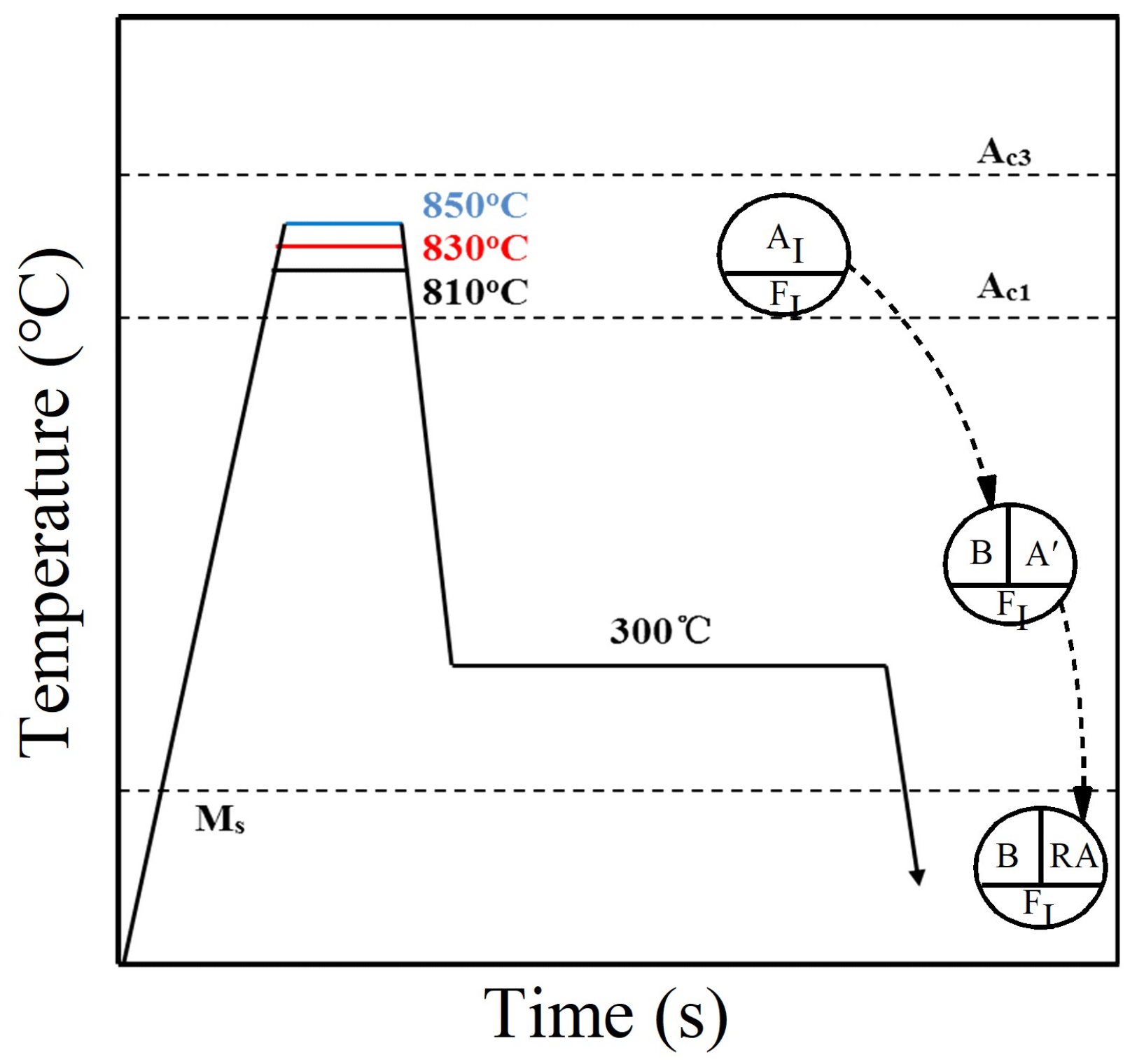
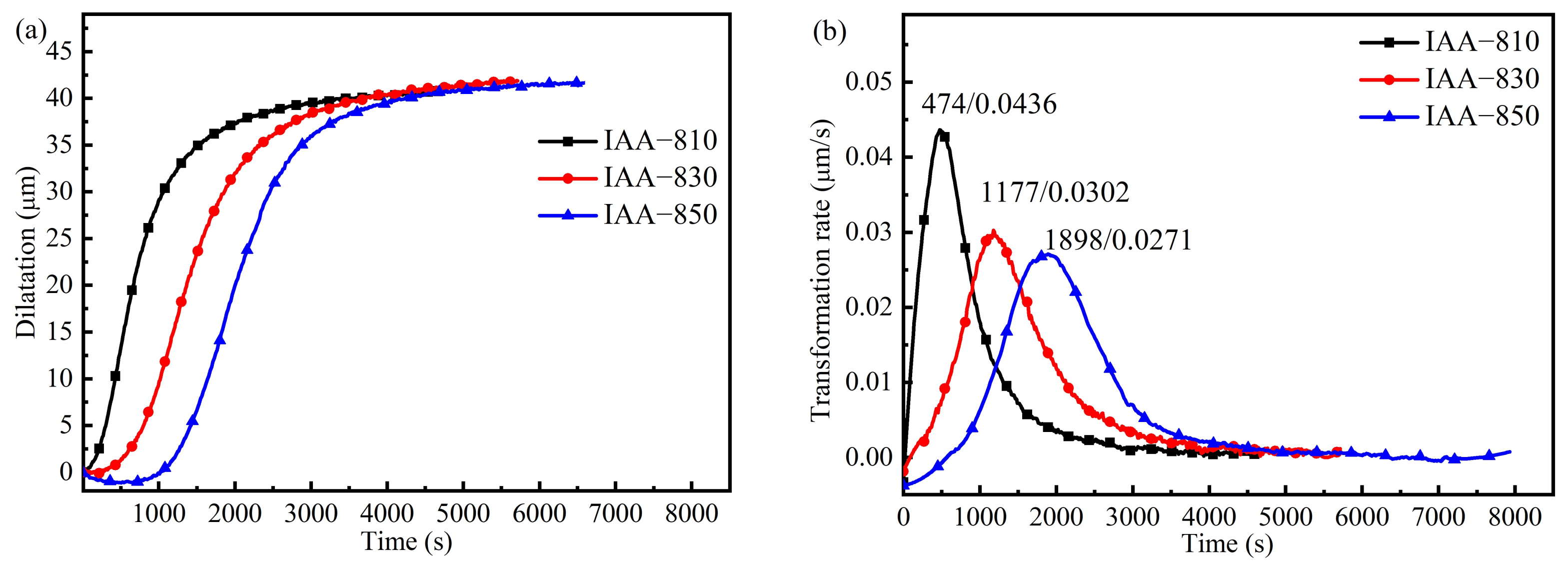

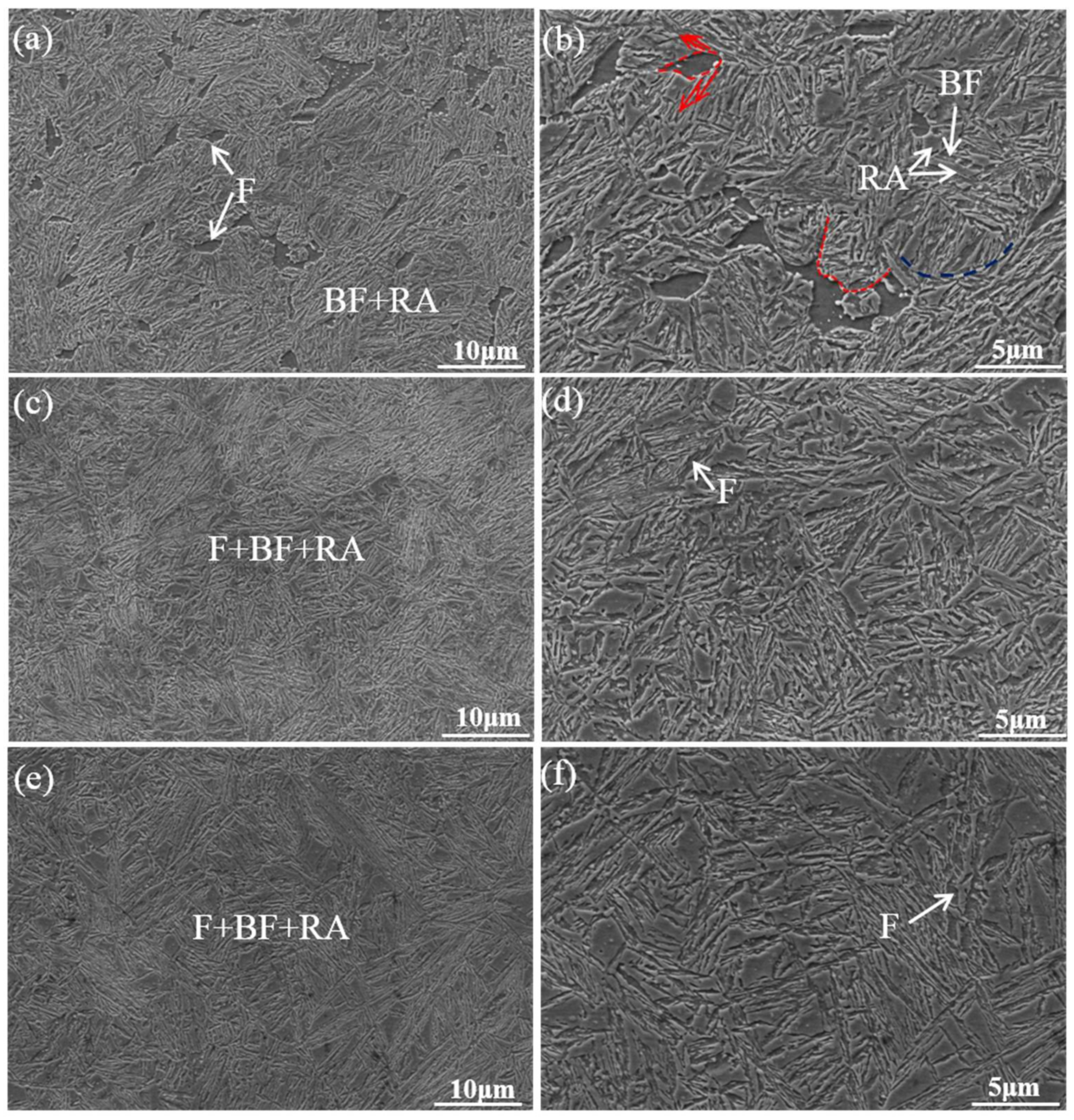
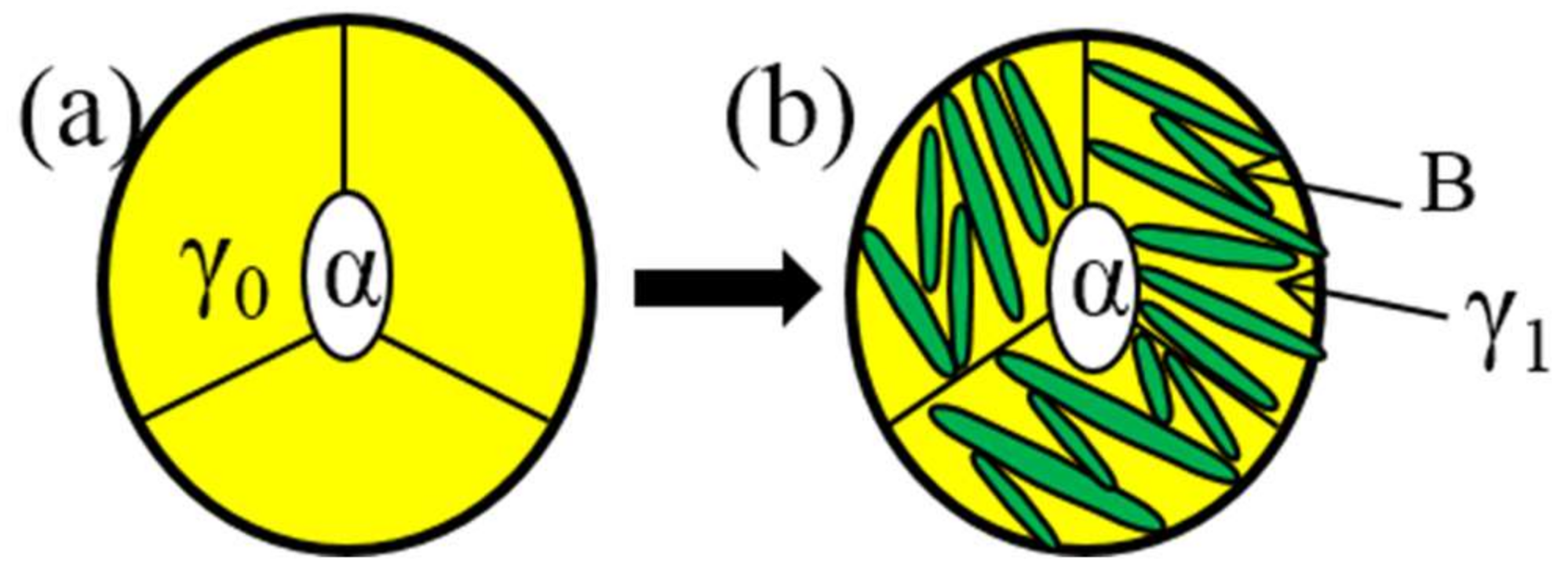

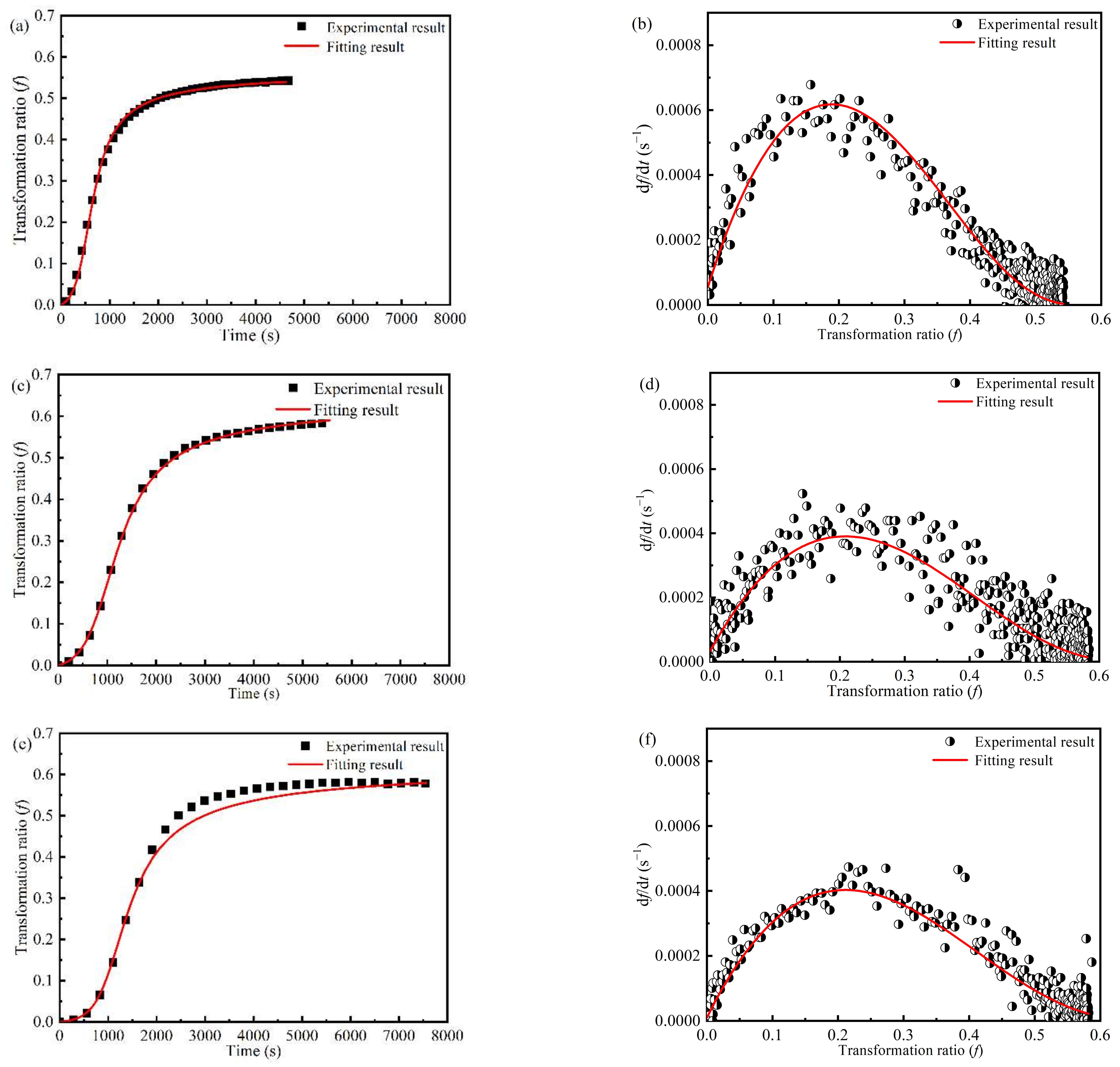

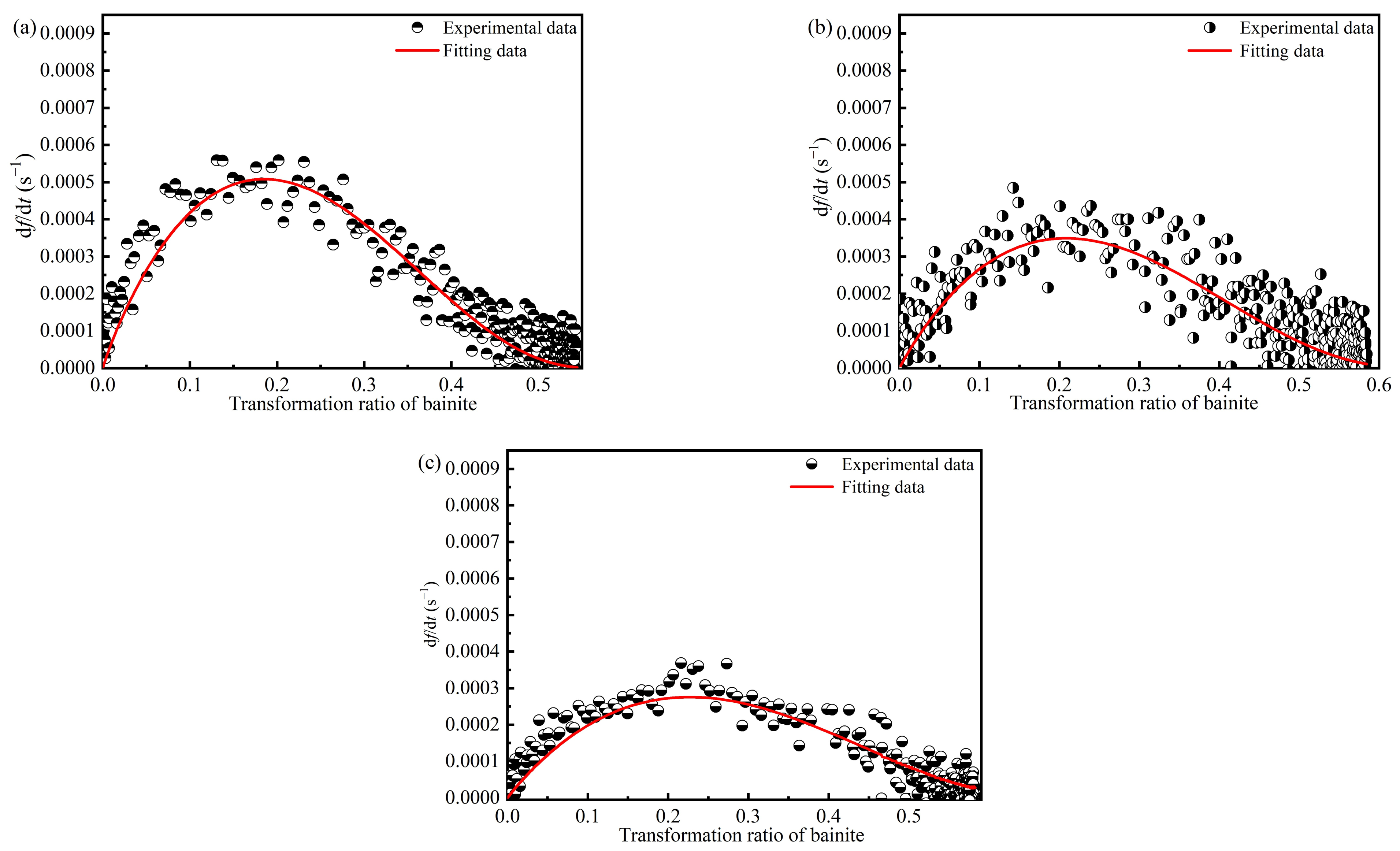
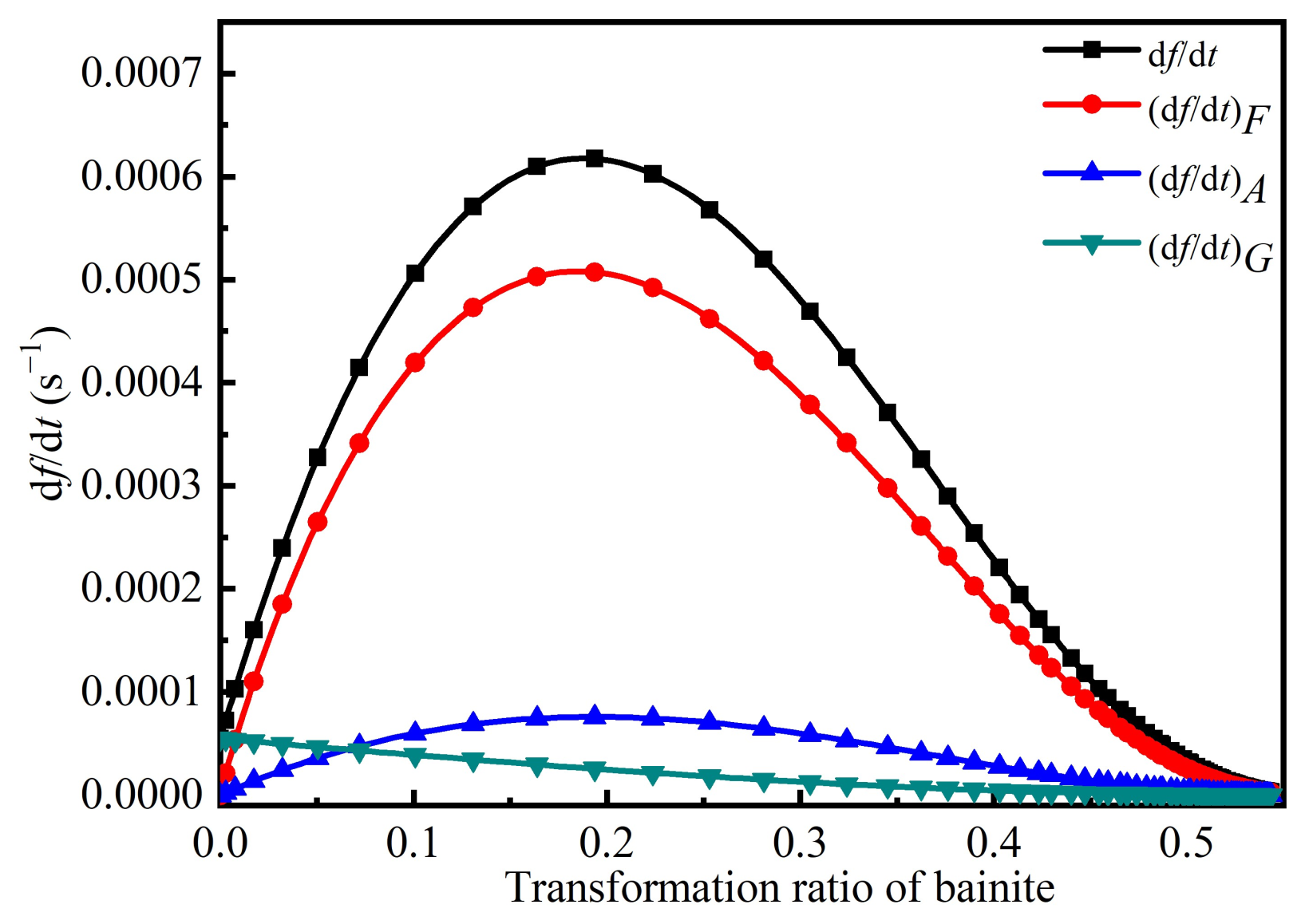

| Specimen | tI (s) | tC (s) | rmax (μm/s) |
|---|---|---|---|
| IAA−810 | 20 | 4680 | 0.0436 |
| IAA−830 | 103 | 5695 | 0.0302 |
| IAA−850 | 6048 | 6018 | 0.0271 |
| Specimen | Ferrite (F) | Bainitic Ferrite (BF) | Retained Austenite (RA) |
|---|---|---|---|
| IAA−810 | 28.6 | 54.4 | 17.0 |
| IAA−830 | 17.4 | 58.4 | 20.0 |
| IAA−850 | 9.3 | 55.9 | 35.3 |
| Specimen | /°C | C1/K | /°C | C2/K | KΓ/J·mol−1·K−1 | m/K−1 | d/μm |
|---|---|---|---|---|---|---|---|
| IAA−810 | 455.0 | 137.2 | 485.8 | 164.5 | 77.8 | 0.0134 | 11.2 |
| IAA−830 | 400.0 | 83.3 | 491.0 | 127.3 | 88.9 | 0.0116 | 12.7 |
| IAA−850 | 409.0 | 85.2 | 499.5 | 163.4 | 96.8 | 0.0123 | 14.7 |
| IAA−810 | IAA−830 | IAA−850 | |
|---|---|---|---|
| a | 9.03 | 7.78 | 2.53 |
| b | −0.061 | −0.039 | −0.025 |
Disclaimer/Publisher’s Note: The statements, opinions and data contained in all publications are solely those of the individual author(s) and contributor(s) and not of MDPI and/or the editor(s). MDPI and/or the editor(s) disclaim responsibility for any injury to people or property resulting from any ideas, methods, instructions or products referred to in the content. |
© 2024 by the authors. Licensee MDPI, Basel, Switzerland. This article is an open access article distributed under the terms and conditions of the Creative Commons Attribution (CC BY) license (https://creativecommons.org/licenses/by/4.0/).
Share and Cite
Yu, X.; Liu, W.; He, K.; Wang, T.; Niu, G.; Wu, H. Experimental and Modelling Research on the Effect of Prior Ferrite on Bainitic Transformation in Medium-Carbon Bainitic Steel. Crystals 2024, 14, 487. https://doi.org/10.3390/cryst14060487
Yu X, Liu W, He K, Wang T, Niu G, Wu H. Experimental and Modelling Research on the Effect of Prior Ferrite on Bainitic Transformation in Medium-Carbon Bainitic Steel. Crystals. 2024; 14(6):487. https://doi.org/10.3390/cryst14060487
Chicago/Turabian StyleYu, Xinpan, Wei Liu, Kang He, Tengfei Wang, Gang Niu, and Huibin Wu. 2024. "Experimental and Modelling Research on the Effect of Prior Ferrite on Bainitic Transformation in Medium-Carbon Bainitic Steel" Crystals 14, no. 6: 487. https://doi.org/10.3390/cryst14060487
APA StyleYu, X., Liu, W., He, K., Wang, T., Niu, G., & Wu, H. (2024). Experimental and Modelling Research on the Effect of Prior Ferrite on Bainitic Transformation in Medium-Carbon Bainitic Steel. Crystals, 14(6), 487. https://doi.org/10.3390/cryst14060487







